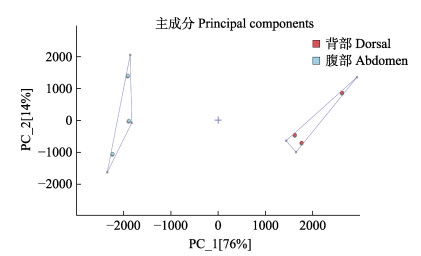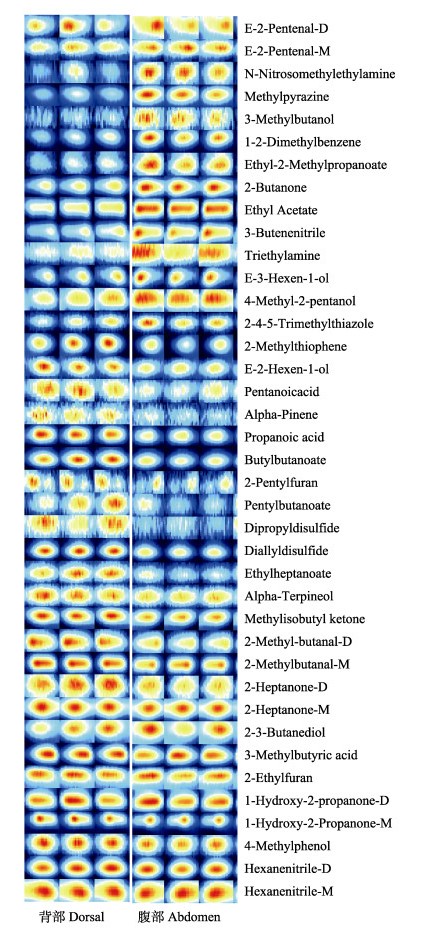2. 山东省中鲁远洋渔业股份有限公司 山东 青岛 266061
2. Shandong Zhonglu Oceanic Fisheries Co. Ltd., Qingdao, Shandong 266061, China
蓝鳍金枪鱼(Thunnus thynnus)属硬骨鱼纲(Osteichthyes)、鲈形目(Perciformes)、鲭科(Scombridae),广泛分布于北半球的太平洋和大西洋海域,是金枪鱼属(Thunnus)中体型最大、经济价值最高的一种(赵巧灵等,2014)。蓝鳍金枪鱼具有很高的营养价值,富含蛋白质、二十碳五烯酸(EPA)和二十二碳六烯酸(DHA)等不饱和脂肪酸、维生素等,有“金枪鱼之王”的美称(王定等, 2009)。
蓝鳍金枪鱼多以生鱼片的方式食用,通常根据脂肪含量的不同,将背、腹部肌肉分成3个部分,鱼体背部称为“赤身”;腹部的中间和末尾称为“中腹”;腹部的前段称为“大腹”。大腹肉油脂丰富,肉质鲜滑而带有浓郁的特有香味,价格最贵;中腹肉肉质鲜美,味道不及大腹浓郁,价格也较之便宜;赤身油脂较少,肉质坚实具嚼感,价格最便宜(廖明涛, 2013)。由于不同部位肌肉的蛋白质、脂肪含量等存在差异,导致营养品质和风味也会有较大差异。目前,国内外关于蓝鳍金枪鱼的研究报道集中在渔业生物学(Brophy et al, 2020; Bennema, 2018)、捕捞(宋利明等, 2021)、遗传多样性(王定等, 2009)等方面。关于营养的研究报道较少,仅邹盈等(2018)将大眼金枪鱼(Thunnus obesus)、黄鳍金枪鱼(Thunnus albacores)和蓝鳍金枪鱼腹部肌肉的营养成分进行对比评价。周胜杰等(2021)评价了中国南海美济礁附近海域大目金枪鱼、蓝鳍金枪鱼和黄鳍金枪鱼3种金枪鱼肉的营养价值,缺乏对蓝鳍金枪鱼不同部位肌肉营养价值与风味的研究。因此,本研究选取蓝鳍金枪鱼背部和腹部(大腹)肌肉为原料,通过测定其基本营养成分、氨基酸、脂肪酸和挥发性风味物质,对比分析不同部位的营养价值及特征风味,旨在为蓝鳍金枪鱼的精深加工利用提供依据。
1 材料与方法 1.1 材料蓝鳍金枪鱼背部和腹部(大腹)肌肉由山东省中鲁远洋渔业股份有限公司提供,捕捞区域:FAO37.1,捕捞时间:2020年2月。
1.2 仪器DHG-9423A型电热恒温鼓风干燥箱,上海精宏实验设备有限公司;K9840凯氏定氮仪,济南海能仪器股份有限公司;ST310索氏脂肪浸提系统,丹麦Foss公司;LX0711箱式高温电阻炉,天津莱玻特瑞仪器设备有限公司;LA8080高速氨基酸分析仪,日本Hitachi公司;BR4I离心机,美国Thermo公司;7890A气相色谱仪,美国Agilent公司;Flavorspace®气相色谱–离子迁移谱仪,德国G.A.S公司。
1.3 方法 1.3.1 基本营养成分测定水分含量按照GB 5009.3-2016采用直接干燥法测定;灰分含量按照GB 5009.4-2016采用高温灼烧法测定;粗蛋白按照GB 5009.5-2016采用凯氏定氮法测定;粗脂肪按照GB 5009.6-2016采用索氏抽提法测定。
1.3.2 不同部位肌肉营养评价蛋白质氨基酸营养品质评价对比FAO/WHO氨基酸评分标准模式及鸡蛋蛋白质模式,分别计算氨基酸评分(AAS)、化学评分(CS)和必需氨基酸指数(EAAI)。
1.3.3 氨基酸组成测定氨基酸含量按照GB 5009.124-2016采用氨基酸自动分析仪测定。
1.3.4 脂肪酸含量测定脂肪酸含量按照GB 5009.168-2016采用外标法测定。
1.3.5 风味物质检测检测条件:MXT-5弱极性柱(15.00 m×0.53 mm, 1.0 μm),色谱柱温度为40℃;载气为N2 (纯度≥99.999%);载气流速程序:初始流速为2.0 mL/min,增速至5.0 mL/min,保持2 min;增速至15 mL/min,保持8 min;增速至50 mL/min,保持5 min;增速至100 mL/min,保持5 min。漂移管温度为45℃;漂移气为N2 (纯度≥99.999%)。
称取3.0 g待测样品于20 mL顶空进样瓶中,用气相离子迁移谱仪进行检测,通过比对NIST数据库和IMS数据库定性分析,采用Gallery Plot功能绘制样品的挥发性成分谱图。
1.3.6 数据处理采用SPSS 25.0进行统计分析,结果以平均值±标准差(Mean±SD)表示,显著性界值以P < 0.05为显著,P > 0.05为不显著。
2 结果与讨论 2.1 蓝鳍金枪鱼不同部位的基本营养成分分析蓝鳍金枪鱼不同部位的基本营养成分见表 1。由表 1可知,除灰分外,蓝鳍金枪鱼背部和腹部肌肉的水分、粗蛋白和脂肪含量差异显著。腹部粗蛋白含量为18.61 g/100 g,背部粗蛋白含量为24.70 g/100 g,背部是腹部的1.33倍;与杨金生等(2013)的研究结果一致。蓝鳍金枪鱼腹部脂肪含量高达30.29 g/100 g,是背部脂肪含量的1.57倍,显著高于邹盈等(2018)研究的蓝鳍金枪鱼腹部脂肪含量,二者存在较大差异可能与海域、捕捞季节等有关,还可能与样品采集部位有关。
|
|
表 1 蓝鳍金枪鱼不同部位肌肉的基本营养成分 Tab.1 Basic nutrient components in different muscle parts of T. thynnus (g/100 g) |
表 2为蓝鳍金枪鱼不同部位肌肉的氨基酸组成,由表 2可知,2个部位肌肉均检测出17种氨基酸(色氨酸除外),氨基酸总量分别达到(22.07±0.74) g/100 g和(16.57±0.47) g/100 g,差异显著(P < 0.05)。必需氨基酸总量分别为(8.61±0.29) g/100 g和(6.28±0.17) g/100 g;背部和腹部肌肉∑EAA/∑TAA值均在40%左右,∑EAA/∑NEAA值均大于60%,接近于FAO/WHO推荐的蛋白质营养评价的理想模式,属于优质蛋白。蓝鳍金枪鱼背部和腹部中谷氨酸的含量均最高,其次为天冬氨酸,而胱氨酸含量最低,这与邹盈等(2018)的研究结果一致。水产品的鲜味与鲜味氨基酸的含量密切相关,背部和腹部肌肉中4种鲜味氨基酸含量均较高,含量顺序均为谷氨酸 > 天冬氨酸 > 丙氨酸 > 甘氨酸,且∑UAA/∑TAA为34.93%~35.91%,均超过30%,这表明蓝鳍金枪鱼背部和腹部肌肉均具有海水鱼类的鲜美品质。
|
|
表 2 蓝鳍金枪鱼不同部位肌肉的氨基酸组成(以湿基计) Tab.2 Amino acid composition in different muscle parts of T. thynnus (in wet basis) |
由表 3可知,蓝鳍金枪鱼背部和腹部肌肉中分别检测出24种和29种脂肪酸,其中,SFA分别为8种、12种,MUFA均为6种,PUFA分别为10种、11种。金枪鱼背部和腹部肌肉中各脂肪酸含量均为PUFA > MUFA > SFA,差异显著(P < 0.05),SFA中肉豆蔻酸(C14:0)、棕榈酸(C16:0)和硬脂酸(C18:0)的含量高;MUFA中油酸(C18:1)和二十碳一烯酸(C20:1)含量高。油酸是最重要的单不饱和脂肪酸,是鱼类生长代谢过程中能量的主要来源(杨彩莉等, 2019)。PUFA是具有独特生理功能的生物活性物质,在视觉系统发育、预防心脑血管疾病、延缓脑衰老等(Martinez et al, 2018; 曹万新等, 2011; Swanson et al, 2012; Frensham et al, 2012)方面具有显著功效。PUFA中DHA含量最高,EPA次之,背部和腹部肌肉中EPA+DHA总量分别占PUFA总量的88.55%和75.13%。因此,蓝鳍金枪鱼背部和腹部肌肉具有很好的保健作用。过量的n-6脂肪酸或者高比例的n-6与n-3多不饱和脂肪酸将引发疾病,较低比例的n-6与n-3多不饱和脂肪酸或较高的n-3不饱和脂肪酸水平则有助于抗炎和抗癌等(段叶辉等, 2014)。WHO/FAO建议膳食中n-6与n-3多不饱和脂肪酸摄入比值应为4~6,而蓝鳍金枪鱼背部和腹部肌肉n-6与n-3多不饱和脂肪酸比值为0.41~0.44,远小于WHO/FAO建议的标准,这表明蓝鳍金枪鱼背部和腹部脂质中富含n-3多不饱和脂肪酸,是优质的n-3多不饱和脂肪酸来源。
|
|
表 3 蓝鳍金枪鱼不同部位肌肉的脂肪酸组成及含量 Tab.3 Fatty acid composition of muscle in different parts of T. thynnus |
蓝鳍金枪鱼背部和腹部肌肉的挥发性物质组成如表 4所示,共检测到39种挥发性物质,包括醛类、酮类、醇类、酯类、酸类和烯烃及含氮、含硫化合物等。
|
|
表 4 蓝鳍金枪鱼不同部位肌肉的挥发性物质组成 Tab.4 Volatile compounds of muscle in different parts of T. thynnus |
图 1是蓝鳍金枪鱼不同部位肌肉挥发性成分的主成分分析,根据PCA分析可知,2组样品分布于X轴的两侧,表明蓝鳍金枪鱼背部和腹部肌肉的气味间有明显差异,GC-IMS可以有效区分蓝鳍金枪鱼背部和腹部肌肉。

|
图 1 蓝鳍金枪鱼不同部位肌肉挥发性成分的主成分分析 Fig.1 Principal component analysis based on volatile compounds of muscle in different muscle parts of T. thynnus |
利用Gallery Plot软件将每个化合物在不同样品中的信号峰排列在一起得到指纹图谱,图 2为蓝鳍金枪鱼不同部位肌肉中挥发性化合物的指纹图谱,从图 2可以清晰地看出挥发性化合物在背部和腹部肌肉中的分布情况。蓝鳍金枪鱼背部肌肉中2-庚酮、2-甲基噻吩、E-2-己烯-1-醇、戊酸、α-蒎烯、丙酸、丁酸丁酯、2-戊基呋喃、丁酸戊酯、二丙基二硫醚、二烯丙基二硫醚、庚酸乙酯、α-松油醇、甲基异丁酮、2-甲基丁醛-D、2-甲基丁醛-M的相对含量较腹部高;腹部肌肉中E-2-戊烯醛、N-亚硝基甲基乙基胺、甲基吡嗪、3-甲基丁醇、二甲苯、三乙胺、E-3-己烯-1-醇、4-甲基-2-戊醇、2-甲基丙酸乙酯、2-丁酮、乙酸乙酯、3-丁烯腈、2, 4, 5-三甲基噻唑的相对含量较高;背部和腹部挥发性风味物质组成和含量的差异使其形成了各自的风味特征。

|
图 2 蓝鳍金枪鱼不同部位肌肉中挥发性化合物的指纹图谱 Fig.2 Fingerprint of volatile compounds of muscle in different muscle parts of T. thynnus 每行代表一种挥发性化合物,每列代表一个样本。每组3个平行,颜色深度表示挥发性化合物的浓度(“M”表示单体,“D”表示二聚体)。 Each row represents a volatile compound, each column represents a sample. 3 parallels in each group. The color depth represents concentration of the volatile compound ("M" means monomer, "D" means dimer). |
醛类物质主要由不饱和脂肪酸氧化产生,其阈值较低,很低的浓度即可产生很浓的风味,2-甲基丁醛被认为是鱼露的特征风味化合物(Zeng et al, 2017),其对蓝鳍金枪鱼背部肌肉总体风味也有重要贡献。一般饱和醇类物质的阈值很高,对气味的贡献不显著,而不饱和醇则有较低的阈值(赵玲等, 2021)。α-松油醇、E-2-己烯-1-醇和E-3-己烯-1-醇对肌肉的整体风味有一定的贡献。酮类化合物可能是由于多不饱和脂肪酸的热氧化或降解、氨基酸降解或微生物氧化产生的,贡献鱼肉甜的花香和果香(赵勇等, 2020)。2-庚酮具有梨香味(赵洪雷等, 2019),2-丁酮具有水果香气(Laura et al, 2018),对背部和腹部肌肉的整体风味有一定的贡献作用。酯类化合物包括丁酸丁酯、丁酸戊酯、庚酸乙酯、乙酸乙酯和2-甲基丙酸乙酯,其由酸和醇类化合物酯化形成的,可以赋予食品一种香甜的果香(胡梦月等, 2020)。呋喃类化合物大都具有较低的风味阈值(王玉等, 2018),2-戊基呋喃的阈值为6 μg/kg,贡献豆香、果香、青香及类似蔬菜的香味。含硫化合物主要来自甲硫氨酸、胱氨酸和半胱氨酸的Strecker降解形成的(Josephson et al, 2002),含硫化合物阈值很低,对新鲜鱼肉中的海味特征香气具有重要贡献。噻吩是一种杂环化合物,也是一种硫醚。新鲜小黄鱼(Larimichthys polyactis) (张晶晶等, 2019)、牡蛎(Ostrea gigas thunberg) (吉思茹, 2016)、鳕鱼(Gadus) (田迪英等, 2015)都曾鉴定出硫醚类化合物,背部肌肉中2-甲基噻吩、二丙基二硫醚和二烯丙基硫醚等浓度较高,使得背部肌肉具有海味特征香气;2, 4, 5-三甲基噻唑对腹部肌肉的风味也有积极的贡献作用。吡嗪类化合物是由含氨基化合物和羰基化合物发生的Maillard反应产生(赵玲等, 2021),主要呈现肉香味和烤香味,吡嗪类既是酱类的特征性风味物质,也是新鲜虾肉中主要的风味物质(赵洪雷等, 2019),甲基吡嗪在腹部肌肉中的浓度高,可能是腹部肌肉香味的重要来源之一。
根据指纹图谱可以看出(图 2),脂肪醛类、酮类和醇类在腹部中含量较高,例如戊醛、2-丁酮、E-2-戊烯醛等物质含量较高,主要产生脂肪香气。而背部鱼肉中气味物质主要以2-甲基丁醛、2-戊基呋喃、二烯丙基二硫醚等物质为主,这些物质的产生与氨基酸的氧化降解有关,另外,甲基异丁酮等支链酮类的产生也与氨基酸降解氧化有关。总的来说,背部和腹部肌肉风味物质的种类和含量有明显差异,主要与2个部位氨基酸和脂质组成有关,腹部主要呈现脂肪香味,而背部鱼肉主要呈现清香味。
3 结论蓝鳍金枪鱼背部和腹部肌肉中均含有丰富的粗蛋白和粗脂肪,其中,背部蛋白含量高,腹部脂肪含量高;氨基酸组成比例合理,接近于FAO/WHO推荐的蛋白质营养评价的理想模式,属于优质蛋白;富含多不饱和脂肪酸,是优质的n-3多不饱和脂肪酸来源;背部和腹部肌肉共检测到包括醛类、酮类、醇类、酯类、酸类和烯烃及含氮、含硫化合物等39种挥发性风味物质,其组成和含量的差异使得背部和腹部肌肉形成了各自的风味特征。蓝鳍金枪鱼背部和腹部肌肉营养丰富、肉质鲜美,是符合人体健康标准的理想食品。
BENNEMA F P. Long-term occurrence of Atlantic bluefin tuna Thunnus thynnus in the North Sea: Contri butions of non-fishery data to population studies. Fisheries Research, 2018, 199: 177-185 DOI:10.1016/j.fishres.2017.11.019 |
BROPHY D, RODRIGUEZ-EZPELETA N, FRAILE I, et al. Combining genetic markers with stable isotopes in otoliths reveals complexity in the stock structure of Atlantic bluefin tuna (Thunnus thynnus). Scientific Reports, 2020, 10(1): 14675 DOI:10.1038/s41598-020-71355-6 |
CAO W X, MENG J, TIAN Y X. Research advance in application and physiological functions of DHA. China Oils and Fats, 2011, 36(3): 1-4 [曹万新, 孟橘, 田玉霞. DHA的生理功能及应用研究进展. 中国油脂, 2011, 36(3): 1-4] |
DUAN Y H, LI F N, LI L L, et al. The regulation of n-6/n-3 polyunsaturated fatty acid ratio in physiological function of the body. Natural Product Research and Development, 2014, 26: 626–631, 479 [段叶辉, 李凤娜, 李丽立, 等. n-6/n-3多不饱和脂肪酸比例对机体生理功能的调节. 天然产物研究与开发, 2014, 26: 626–631, 479] |
FRENSHAM L J, BRYAN J, PARLETTA N. Influences of micronutrient and omega-3 fatty acid supplementation on cognition learning and behavior: Methodological considerations and implications for children and dolescents in developed societies. Nutrition Reviews, 2012, 70(10): 594-610 DOI:10.1111/j.1753-4887.2012.00516.x |
HU M Y, WANG S Y, XUE Y, et al. Changes in flavor characteristics of dried shrimps during processing. Chinese Fishery Quality and Standards, 2020, 10(6): 10-16 [胡梦月, 王善宇, 薛勇, 等. 即食虾干加工过程风味变化. 中国渔业质量与标准, 2020, 10(6): 10-16] |
JI S R. Identification of key odorants in steamed Chinese mitten crab. Master′s Thesis of Shanghai Ocean University, 2016, 16–17 [吉思茹. 蒸制中华绒螯蟹关键性气味物质的鉴定研究. 上海海洋大学硕士研究生学位论文, 2016, 16–17]
|
JOSEPHSON D B, LINDSAY R C, STUIBER D A. Identification of compounds characterizing the aroma of fresh whitefish (Coregonus clupeaformis). Journal of Agricultural and Food Chemistry, 2002, 31(2): 326-330 |
LAURA P S, REBECA M, CARMELA B, et al. Nitrate reduction in the fermentation process of salt reduced dry sausages: Impact on microbial and physicochemical parameters and aroma profile. International Journal of Food Microbiology, 2018, 282(1): 84-91 |
LIAO M T. Study on the color change of Bluefin Tuna thunnus orientalis under freezing storage conditions. Master′s Thesis of Zhejiang Gongshang University, 2013 [廖明涛. 冻藏条件下蓝鳍金枪鱼鱼肉色泽变化的研究. 浙江工商大学硕士研究生学位论文, 2013]
|
MARTINEZ L E E, ROJAS H R A, SEGURA C M R, et al. Bioactive molecules in food. New York: Springer, 2018, 1–17
|
SONG L M, XU H. A review of tuna longline catch performance. Journal of Fishery Sciences of China, 2021, 28(7): 925-937 [宋利明, 许回. 金枪鱼延绳钓渔获性能研究进展. 中国水产科学, 2021, 28(7): 925-937] |
SWANSON D, BLOCK R, MOUSA S A. Omega-3 fatty acids EPA and DHA: Health benefits throughout life. Advances in Nutrition: An International Review Journal, 2012, 3(1): 1-7 DOI:10.3945/an.111.000893 |
TIAN D Y, JIAO H, TAO W, et al. Analysis of volatile flavor components of five kinds of marine fish. Food and Fermentation Industries, 2015, 41(10): 155-159 [田迪英, 焦慧, 陶崴, 等. 5种海鱼挥发性风味成分分析. 食品与发酵工业, 2015, 41(10): 155-159] |
WANG D, SU Y Q, MAO Y, et al. Genetic diversity of Thunnus thynnus and Thunnus albacares stocks by AFLP. Journal of Xiamen University (Natural Science), 2009, 48(6): 890-894 [王定, 苏永全, 毛勇, 等. 蓝鳍金枪鱼和黄鳍金枪鱼遗传多样性的AFLP分析. 厦门大学学报(自然科学版), 2009, 48(6): 890-894] |
WANG W, WANG R D, XUE Y, et al. Analysis of volatile flavor compounds changes during traditional processing of salted Spanish mackerel. Modern Food Science and Technology, 2018, 34(9): 268-275 [王玉, 王睿迪, 薛勇, 等. 传统加工咸鲅鱼的挥发性风味成分. 现代食品科技, 2018, 34(9): 268-275] |
YANG C L, CAO X J, ZHANG Y C, et al. Comparative composition and nutritional evaluation of different head parts of three tuna species. Meat Research, 2019, 33(10): 8-14 [杨彩莉, 曹晓杰, 张渊超, 等. 3种金枪鱼头不同部位成分比较及营养学评价. 肉类研究, 2019, 33(10): 8-14] |
YANG J S, HUO J C, XIA S Y. The analysis of nutrients of different tuna. Journal of Zhejiang Ocean University (Natural Science), 2013, 32(5): 393-397 [杨金生, 霍健聪, 夏松养. 不同品种金枪鱼营养成分的研究与分析. 浙江海洋学院学报(自然科学版), 2013, 32(5): 393-397] |
ZENG X F, XIA W S, JIANG Q X, et al. Contribution of mixed starter cultures to flavor profile of Suan yu traditional Chinese low-salt fermented whole fish. Journal of Food Processing and Preservation, 2017, 41(5): 1-15 |
ZHANG J J, WANG X C, SHI W Z. Identification of volatile compounds in white croaker and small yellow croaker. Food Science, 2019, 40(14): 206-213 [张晶晶, 王锡昌, 施文正. 白姑鱼和小黄鱼肉中挥发性风味物质的鉴定. 食品科学, 2019, 40(14): 206-213] |
ZHAO H L, YIN Y M, CHEN Y Y, et al. Flavor characteristics of shrimp pastes from different regions and variance analysis. Food and Fermentation Industries, 2019, 45(10): 194-200 [赵洪雷, 尹一鸣, 陈义莹, 等. 不同产地虾酱风味特征及差异分析. 食品与发酵工业, 2019, 45(10): 194-200] |
ZHAO L, CAO R, WANG L Z, et al. Study on the characteristic flavor change of Porphyra yezoensis before and after roasting. Progress in Fishery Sciences, 2021, 42(4): 199-207 [赵玲, 曹荣, 王联珠, 等. 条斑紫菜烤制前后特征风味变化研究. 渔业科学进展, 2021, 42(4): 199-207] |
ZHAO Q L, LIAO M T, LIU S C, et al. Research on the change of lipid oxidation and meat color of bluefin tuna. Journal of Chinese Institute of Food Science and Technology, 2014, 14(7): 79-86 [赵巧灵, 廖明涛, 刘书臣, 等. 蓝鳍金枪鱼脂肪氧化和鱼肉色泽的变化研究. 中国食品学报, 2014, 14(7): 79-86] |
ZHAO Y, JIANG D F, ZHU K W, et al. Study on the characteristics of volatile flavor component. Journal of Food Safety and Quality, 2020, 11(3): 734-743 [赵勇, 蒋东丰, 朱克卫, 等. 不同产地进口三文鱼挥发风味物质组成特征研究. 食品安全质量检测学报, 2020, 11(3): 734-743] |
ZHOU S J, YANG R, YU G, et al. Muscle composition determination and nutrition evaluation of three tuna species near Meiji Reef. South China Fisheries Science, 2021, 17(2): 51-59 [周胜杰, 杨蕊, 于刚, 等. 美济礁附近海域3种金枪鱼肌肉成分检测与营养评价. 南方水产科学, 2021, 17(2): 51-59] |
ZOU Y, LI Y P, DAI Z Y, et al. Analysis and evaluation on nutritional components of three kinds of tuna. Farm Products Processing, 2018, 456(10): 47-51 [邹盈, 李彦坡, 戴志远, 等. 三种金枪鱼营养成分分析与评价. 农产品加工, 2018, 456(10): 47-51] |



